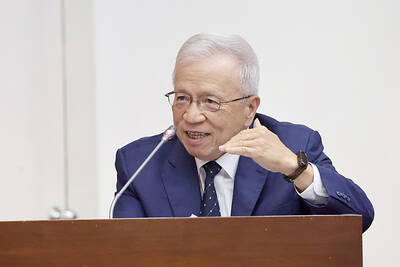Toshiba Corp chief executive officer Nobuaki Kurumatani resigned yesterday as a buyout offer from a private equity fund stirs turmoil inside the storied Japanese company, with reports suggesting that two other funds are considering bids.
Kurumatani’s resignation is the latest development in years of upheaval at the firm, which in January won back its spot on the first section of the Tokyo Stock Exchange after restructuring.
The board accepted Kurumatani’s resignation “as he has completed his mission of revitalizing Toshiba,” Osamu Nagayama, head of the firm’s appointment committee, told reporters after the company confirmed the departure.

Photo: AFP
Kurumatani declined to appear before journalists, but a statement from him was read out at the event.
His departure comes as board members raise questions about the buyout offer from CVC Capital Partners Ltd, where Kurumatani formerly headed Japanese operations — although Nagayama has said that conflict of interest allegations had “nothing to do” with the resignation.
The private equity firm is reportedly offering a deal in excess of US$20 billion, but there are reports that some at Toshiba see that sum as too small.
Kuramtani’s departure is likely to be seen as a reflection of internal disagreements over the CVC offer.
The Financial Times reported that another private equity fund, KKR & Co Inc, is planning to offer its own larger buyout proposal.
Bloomberg News reported that a third fund, Canadian Brookfield Asset Management Inc, is also exploring a possible offer.
Toshiba officials did not address the reports at yesterday’s news conference.
Toshiba last week confirmed that it had received the CVC offer, which would take Toshiba private.
Delisting the firm could produce faster decisionmaking by Toshiba’s management, which has over the past few months clashed with shareholders.
It could also allow Toshiba to concentrate resources on renewable energies and other core businesses.
However, any buyout offer is likely to face significant challenges, including securing financing and regulatory approval.
Nagayama said that Toshiba would consider CVC’s offer cautiously, but warned that it “lacks detail as an initial proposal.”
“It’s not something Toshiba has asked for, and it has come suddenly,” he said.
“We will make the best choice for shareholders, our employees, and society” if a formal proposal is made, Kurumatani’s successor, Satoshi Tsunakawa, said.
Kurumatani worked for CVC from 2017 to 2018, and his departure would “remove uncertainty over potential conflicts of interest”, said Justin Tang (鄧文雄), head of Asian research at United First Partners.
It will also “force the board to seek other offers that are in the best interests of shareholders,” he said. “It is a very sticky situation at present.”
CVC reportedly hopes to secure financing assistance for its buyout bid, and Toshiba last week said that the bid was likely to involve “a substantial amount of time and considerable complexity.”
The CVC offer is reportedly about ¥5,000 per share, but Tang said that he believes “a price north of ¥6,000 is necessary to get shareholders over the line.”
Toshiba shares yesterday closed up 5.76 percent at ¥4,860.

JITTERS: Nexperia has a 20 percent market share for chips powering simpler features such as window controls, and changing supply chains could take years European carmakers are looking into ways to scratch components made with parts from China, spooked by deepening geopolitical spats playing out through chipmaker Nexperia BV and Beijing’s export controls on rare earths. To protect operations from trade ructions, several automakers are pushing major suppliers to find permanent alternatives to Chinese semiconductors, people familiar with the matter said. The industry is considering broader changes to its supply chain to adapt to shifting geopolitics, Europe’s main suppliers lobby CLEPA head Matthias Zink said. “We had some indications already — questions like: ‘How can you supply me without this dependency on China?’” Zink, who also

At least US$50 million for the freedom of an Emirati sheikh: That is the king’s ransom paid two weeks ago to militants linked to al-Qaeda who are pushing to topple the Malian government and impose Islamic law. Alongside a crippling fuel blockade, the Group for the Support of Islam and Muslims (JNIM) has made kidnapping wealthy foreigners for a ransom a pillar of its strategy of “economic jihad.” Its goal: Oust the junta, which has struggled to contain Mali’s decade-long insurgency since taking power following back-to-back coups in 2020 and 2021, by scaring away investors and paralyzing the west African country’s economy.

BUST FEARS: While a KMT legislator asked if an AI bubble could affect Taiwan, the DGBAS minister said the sector appears on track to continue growing The local property market has cooled down moderately following a series of credit control measures designed to contain speculation, the central bank said yesterday, while remaining tight-lipped about potential rule relaxations. Lawmakers in a meeting of the legislature’s Finance Committee voiced concerns to central bank officials that the credit control measures have adversely affected the government’s tax income and small and medium-sized property developers, with limited positive effects. Housing prices have been climbing since 2016, even when the central bank imposed its first set of control measures in 2020, Chinese Nationalist Party (KMT) Legislator Lo Ting-wei (羅廷瑋) said. “Since the second half of

Taiwan Semiconductor Manufacturing Co (TSMC, 台積電) received about NT$147 billion (US$4.71 billion) in subsidies from the US, Japanese, German and Chinese governments over the past two years for its global expansion. Financial data compiled by the world’s largest contract chipmaker showed the company secured NT$4.77 billion in subsidies from the governments in the third quarter, bringing the total for the first three quarters of the year to about NT$71.9 billion. Along with the NT$75.16 billion in financial aid TSMC received last year, the chipmaker obtained NT$147 billion in subsidies in almost two years, the data showed. The subsidies received by its subsidiaries —